Research Critique
VerifiedAdded on 2022/11/15
|10
|2564
|499
AI Summary
This paper critically analyzes two qualitative and quantitative studies based on the PICOT question. The aim is to evaluate the actions that can lower the incidence of catheter-associated infection. The paper provides valuable information by utilizing evidence-based research.
Contribute Materials
Your contribution can guide someone’s learning journey. Share your
documents today.
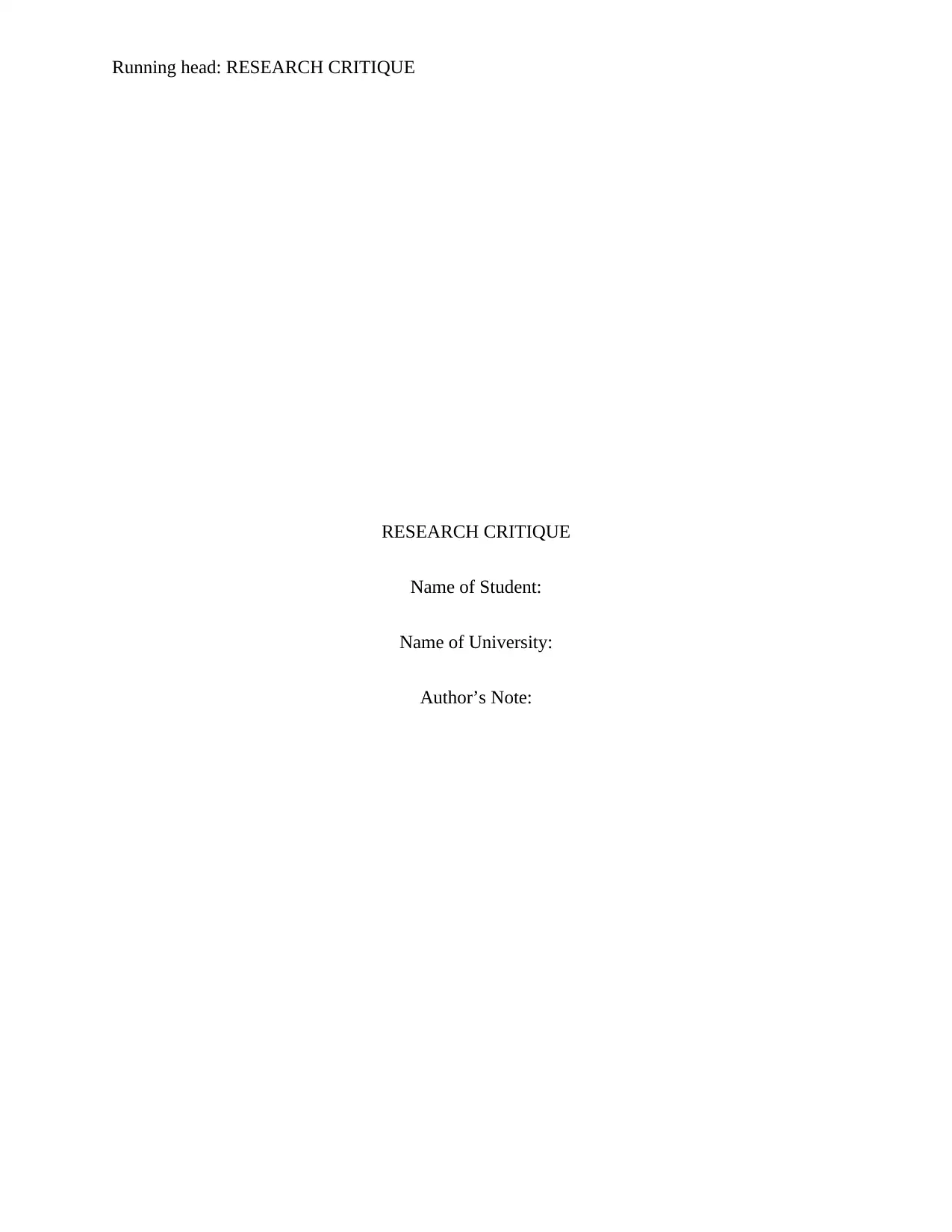
Running head: RESEARCH CRITIQUE
RESEARCH CRITIQUE
Name of Student:
Name of University:
Author’s Note:
RESEARCH CRITIQUE
Name of Student:
Name of University:
Author’s Note:
Secure Best Marks with AI Grader
Need help grading? Try our AI Grader for instant feedback on your assignments.
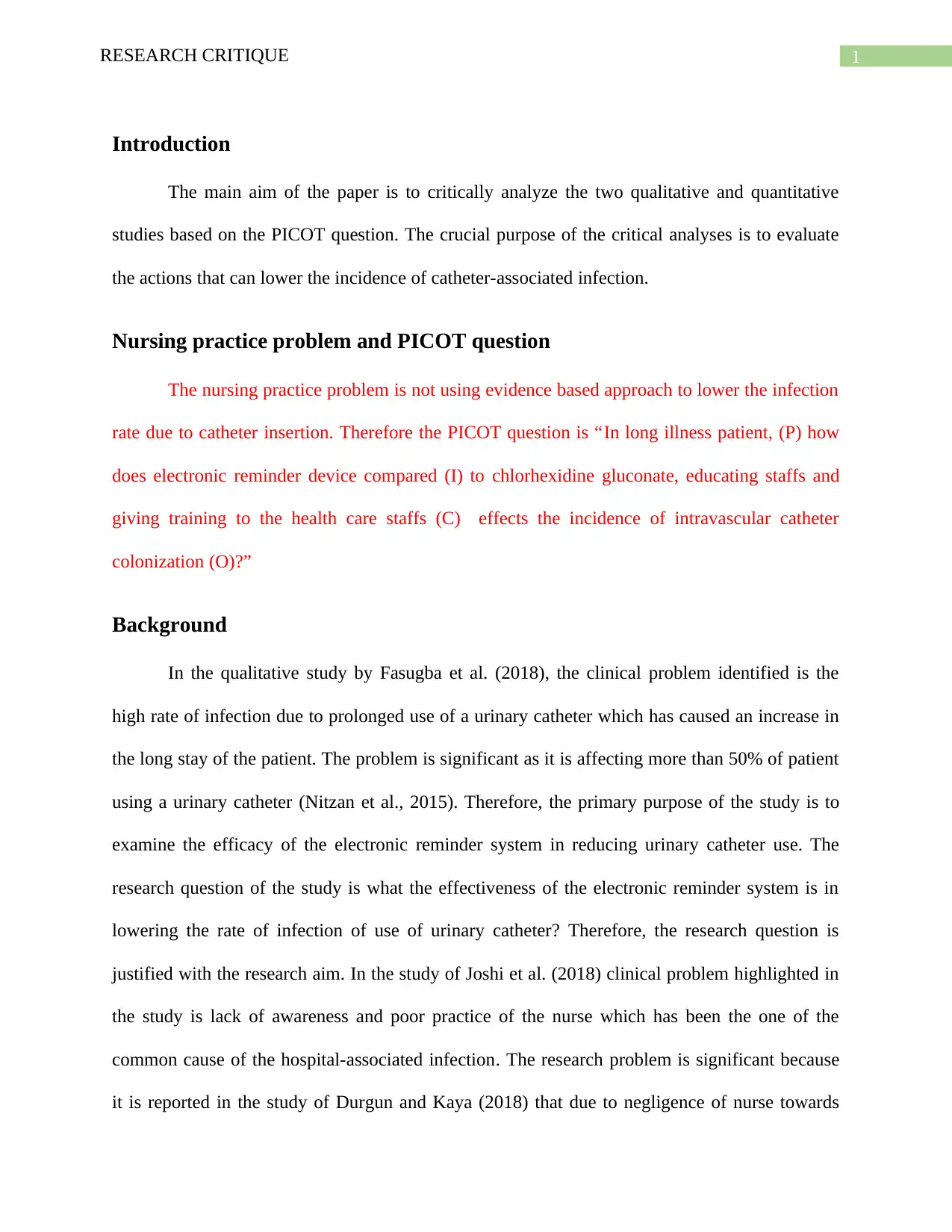
1RESEARCH CRITIQUE
Introduction
The main aim of the paper is to critically analyze the two qualitative and quantitative
studies based on the PICOT question. The crucial purpose of the critical analyses is to evaluate
the actions that can lower the incidence of catheter-associated infection.
Nursing practice problem and PICOT question
The nursing practice problem is not using evidence based approach to lower the infection
rate due to catheter insertion. Therefore the PICOT question is “In long illness patient, (P) how
does electronic reminder device compared (I) to chlorhexidine gluconate, educating staffs and
giving training to the health care staffs (C) effects the incidence of intravascular catheter
colonization (O)?”
Background
In the qualitative study by Fasugba et al. (2018), the clinical problem identified is the
high rate of infection due to prolonged use of a urinary catheter which has caused an increase in
the long stay of the patient. The problem is significant as it is affecting more than 50% of patient
using a urinary catheter (Nitzan et al., 2015). Therefore, the primary purpose of the study is to
examine the efficacy of the electronic reminder system in reducing urinary catheter use. The
research question of the study is what the effectiveness of the electronic reminder system is in
lowering the rate of infection of use of urinary catheter? Therefore, the research question is
justified with the research aim. In the study of Joshi et al. (2018) clinical problem highlighted in
the study is lack of awareness and poor practice of the nurse which has been the one of the
common cause of the hospital-associated infection. The research problem is significant because
it is reported in the study of Durgun and Kaya (2018) that due to negligence of nurse towards
Introduction
The main aim of the paper is to critically analyze the two qualitative and quantitative
studies based on the PICOT question. The crucial purpose of the critical analyses is to evaluate
the actions that can lower the incidence of catheter-associated infection.
Nursing practice problem and PICOT question
The nursing practice problem is not using evidence based approach to lower the infection
rate due to catheter insertion. Therefore the PICOT question is “In long illness patient, (P) how
does electronic reminder device compared (I) to chlorhexidine gluconate, educating staffs and
giving training to the health care staffs (C) effects the incidence of intravascular catheter
colonization (O)?”
Background
In the qualitative study by Fasugba et al. (2018), the clinical problem identified is the
high rate of infection due to prolonged use of a urinary catheter which has caused an increase in
the long stay of the patient. The problem is significant as it is affecting more than 50% of patient
using a urinary catheter (Nitzan et al., 2015). Therefore, the primary purpose of the study is to
examine the efficacy of the electronic reminder system in reducing urinary catheter use. The
research question of the study is what the effectiveness of the electronic reminder system is in
lowering the rate of infection of use of urinary catheter? Therefore, the research question is
justified with the research aim. In the study of Joshi et al. (2018) clinical problem highlighted in
the study is lack of awareness and poor practice of the nurse which has been the one of the
common cause of the hospital-associated infection. The research problem is significant because
it is reported in the study of Durgun and Kaya (2018) that due to negligence of nurse towards
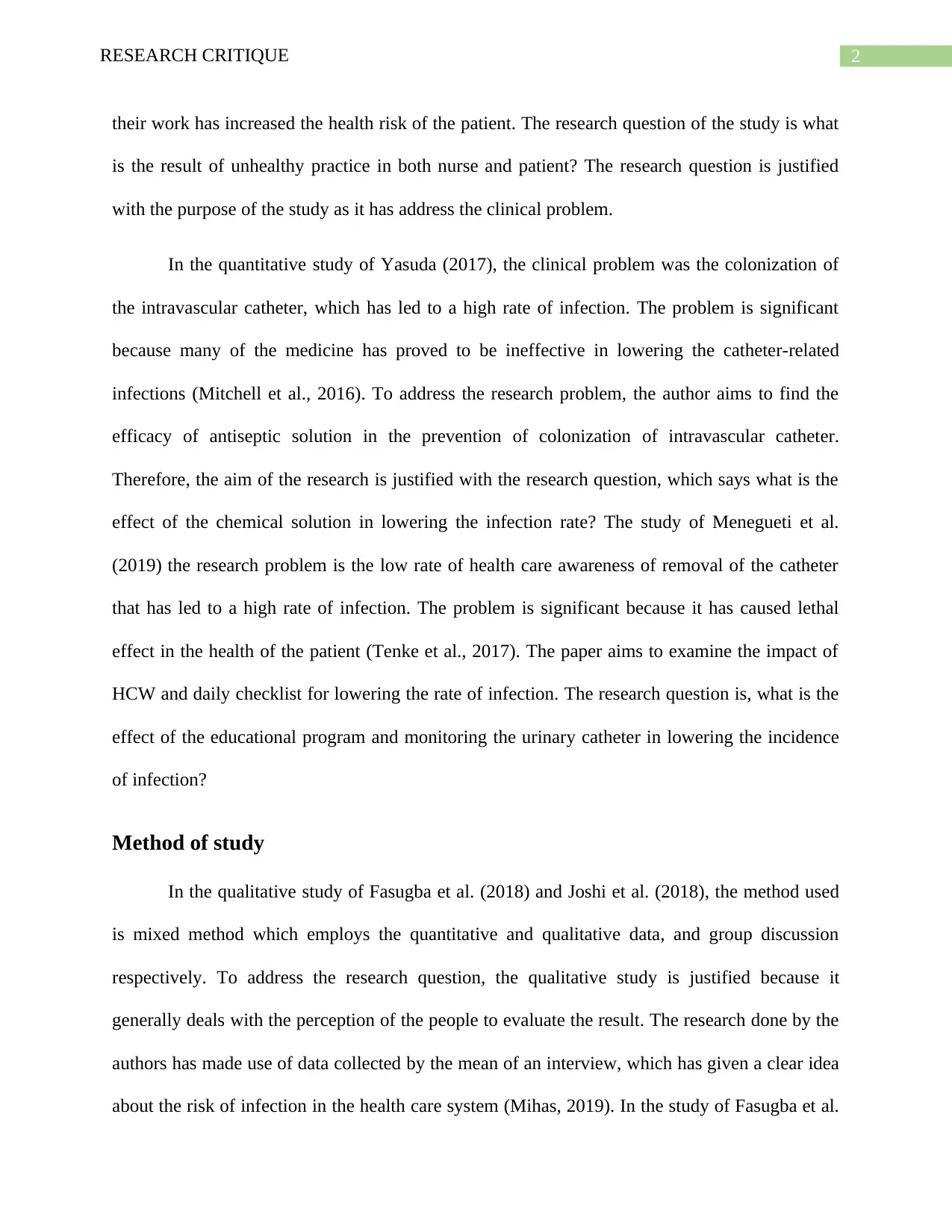
2RESEARCH CRITIQUE
their work has increased the health risk of the patient. The research question of the study is what
is the result of unhealthy practice in both nurse and patient? The research question is justified
with the purpose of the study as it has address the clinical problem.
In the quantitative study of Yasuda (2017), the clinical problem was the colonization of
the intravascular catheter, which has led to a high rate of infection. The problem is significant
because many of the medicine has proved to be ineffective in lowering the catheter-related
infections (Mitchell et al., 2016). To address the research problem, the author aims to find the
efficacy of antiseptic solution in the prevention of colonization of intravascular catheter.
Therefore, the aim of the research is justified with the research question, which says what is the
effect of the chemical solution in lowering the infection rate? The study of Menegueti et al.
(2019) the research problem is the low rate of health care awareness of removal of the catheter
that has led to a high rate of infection. The problem is significant because it has caused lethal
effect in the health of the patient (Tenke et al., 2017). The paper aims to examine the impact of
HCW and daily checklist for lowering the rate of infection. The research question is, what is the
effect of the educational program and monitoring the urinary catheter in lowering the incidence
of infection?
Method of study
In the qualitative study of Fasugba et al. (2018) and Joshi et al. (2018), the method used
is mixed method which employs the quantitative and qualitative data, and group discussion
respectively. To address the research question, the qualitative study is justified because it
generally deals with the perception of the people to evaluate the result. The research done by the
authors has made use of data collected by the mean of an interview, which has given a clear idea
about the risk of infection in the health care system (Mihas, 2019). In the study of Fasugba et al.
their work has increased the health risk of the patient. The research question of the study is what
is the result of unhealthy practice in both nurse and patient? The research question is justified
with the purpose of the study as it has address the clinical problem.
In the quantitative study of Yasuda (2017), the clinical problem was the colonization of
the intravascular catheter, which has led to a high rate of infection. The problem is significant
because many of the medicine has proved to be ineffective in lowering the catheter-related
infections (Mitchell et al., 2016). To address the research problem, the author aims to find the
efficacy of antiseptic solution in the prevention of colonization of intravascular catheter.
Therefore, the aim of the research is justified with the research question, which says what is the
effect of the chemical solution in lowering the infection rate? The study of Menegueti et al.
(2019) the research problem is the low rate of health care awareness of removal of the catheter
that has led to a high rate of infection. The problem is significant because it has caused lethal
effect in the health of the patient (Tenke et al., 2017). The paper aims to examine the impact of
HCW and daily checklist for lowering the rate of infection. The research question is, what is the
effect of the educational program and monitoring the urinary catheter in lowering the incidence
of infection?
Method of study
In the qualitative study of Fasugba et al. (2018) and Joshi et al. (2018), the method used
is mixed method which employs the quantitative and qualitative data, and group discussion
respectively. To address the research question, the qualitative study is justified because it
generally deals with the perception of the people to evaluate the result. The research done by the
authors has made use of data collected by the mean of an interview, which has given a clear idea
about the risk of infection in the health care system (Mihas, 2019). In the study of Fasugba et al.
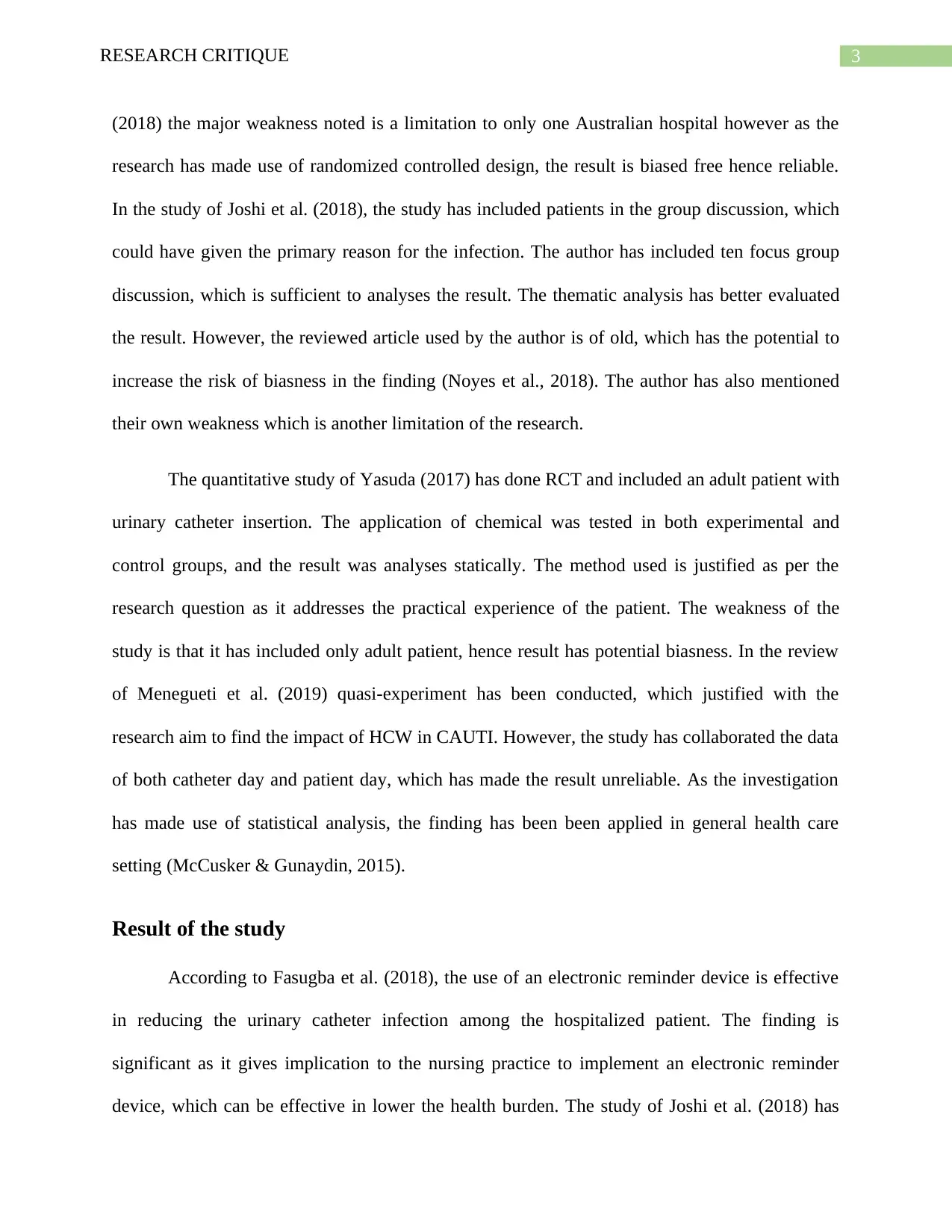
3RESEARCH CRITIQUE
(2018) the major weakness noted is a limitation to only one Australian hospital however as the
research has made use of randomized controlled design, the result is biased free hence reliable.
In the study of Joshi et al. (2018), the study has included patients in the group discussion, which
could have given the primary reason for the infection. The author has included ten focus group
discussion, which is sufficient to analyses the result. The thematic analysis has better evaluated
the result. However, the reviewed article used by the author is of old, which has the potential to
increase the risk of biasness in the finding (Noyes et al., 2018). The author has also mentioned
their own weakness which is another limitation of the research.
The quantitative study of Yasuda (2017) has done RCT and included an adult patient with
urinary catheter insertion. The application of chemical was tested in both experimental and
control groups, and the result was analyses statically. The method used is justified as per the
research question as it addresses the practical experience of the patient. The weakness of the
study is that it has included only adult patient, hence result has potential biasness. In the review
of Menegueti et al. (2019) quasi-experiment has been conducted, which justified with the
research aim to find the impact of HCW in CAUTI. However, the study has collaborated the data
of both catheter day and patient day, which has made the result unreliable. As the investigation
has made use of statistical analysis, the finding has been been applied in general health care
setting (McCusker & Gunaydin, 2015).
Result of the study
According to Fasugba et al. (2018), the use of an electronic reminder device is effective
in reducing the urinary catheter infection among the hospitalized patient. The finding is
significant as it gives implication to the nursing practice to implement an electronic reminder
device, which can be effective in lower the health burden. The study of Joshi et al. (2018) has
(2018) the major weakness noted is a limitation to only one Australian hospital however as the
research has made use of randomized controlled design, the result is biased free hence reliable.
In the study of Joshi et al. (2018), the study has included patients in the group discussion, which
could have given the primary reason for the infection. The author has included ten focus group
discussion, which is sufficient to analyses the result. The thematic analysis has better evaluated
the result. However, the reviewed article used by the author is of old, which has the potential to
increase the risk of biasness in the finding (Noyes et al., 2018). The author has also mentioned
their own weakness which is another limitation of the research.
The quantitative study of Yasuda (2017) has done RCT and included an adult patient with
urinary catheter insertion. The application of chemical was tested in both experimental and
control groups, and the result was analyses statically. The method used is justified as per the
research question as it addresses the practical experience of the patient. The weakness of the
study is that it has included only adult patient, hence result has potential biasness. In the review
of Menegueti et al. (2019) quasi-experiment has been conducted, which justified with the
research aim to find the impact of HCW in CAUTI. However, the study has collaborated the data
of both catheter day and patient day, which has made the result unreliable. As the investigation
has made use of statistical analysis, the finding has been been applied in general health care
setting (McCusker & Gunaydin, 2015).
Result of the study
According to Fasugba et al. (2018), the use of an electronic reminder device is effective
in reducing the urinary catheter infection among the hospitalized patient. The finding is
significant as it gives implication to the nursing practice to implement an electronic reminder
device, which can be effective in lower the health burden. The study of Joshi et al. (2018) has
Secure Best Marks with AI Grader
Need help grading? Try our AI Grader for instant feedback on your assignments.
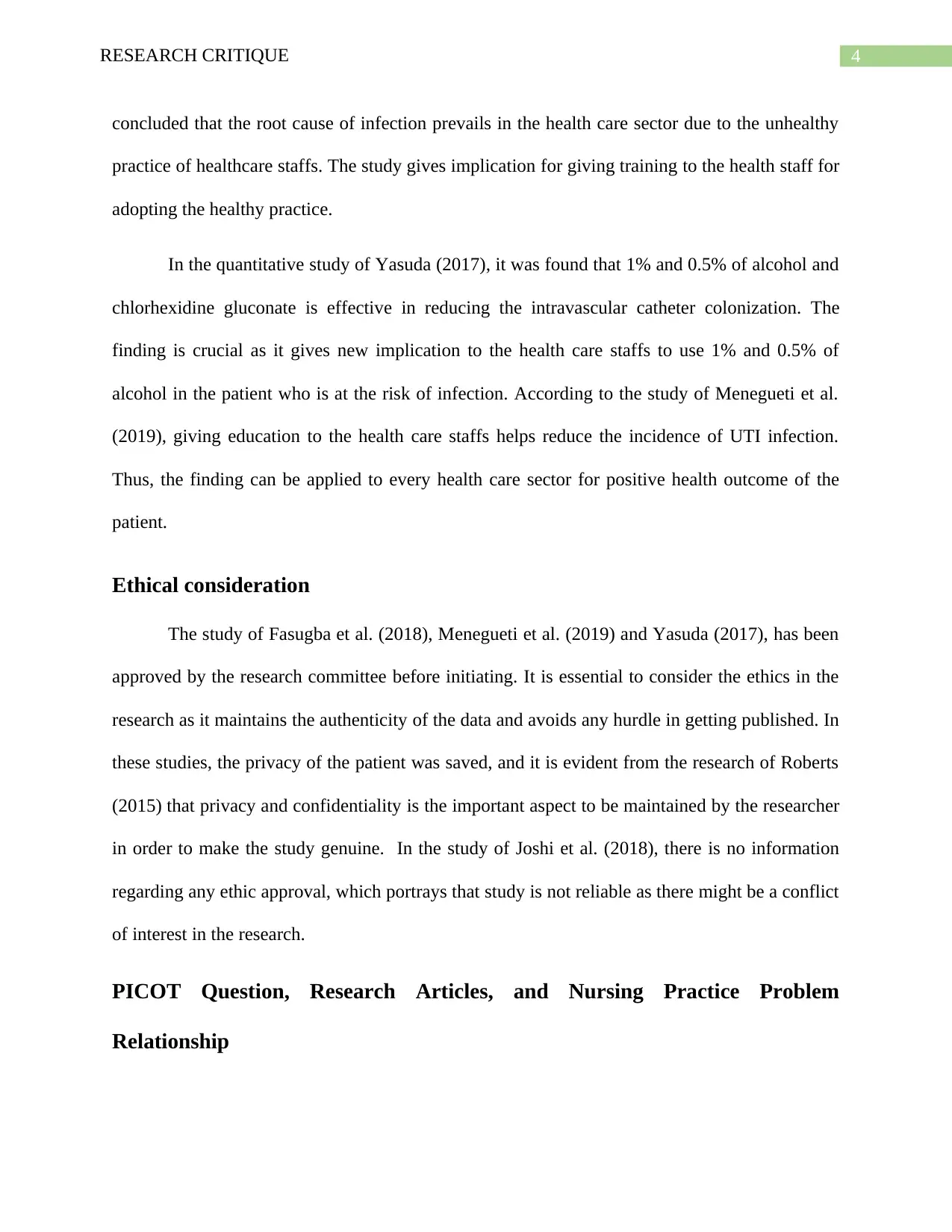
4RESEARCH CRITIQUE
concluded that the root cause of infection prevails in the health care sector due to the unhealthy
practice of healthcare staffs. The study gives implication for giving training to the health staff for
adopting the healthy practice.
In the quantitative study of Yasuda (2017), it was found that 1% and 0.5% of alcohol and
chlorhexidine gluconate is effective in reducing the intravascular catheter colonization. The
finding is crucial as it gives new implication to the health care staffs to use 1% and 0.5% of
alcohol in the patient who is at the risk of infection. According to the study of Menegueti et al.
(2019), giving education to the health care staffs helps reduce the incidence of UTI infection.
Thus, the finding can be applied to every health care sector for positive health outcome of the
patient.
Ethical consideration
The study of Fasugba et al. (2018), Menegueti et al. (2019) and Yasuda (2017), has been
approved by the research committee before initiating. It is essential to consider the ethics in the
research as it maintains the authenticity of the data and avoids any hurdle in getting published. In
these studies, the privacy of the patient was saved, and it is evident from the research of Roberts
(2015) that privacy and confidentiality is the important aspect to be maintained by the researcher
in order to make the study genuine. In the study of Joshi et al. (2018), there is no information
regarding any ethic approval, which portrays that study is not reliable as there might be a conflict
of interest in the research.
PICOT Question, Research Articles, and Nursing Practice Problem
Relationship
concluded that the root cause of infection prevails in the health care sector due to the unhealthy
practice of healthcare staffs. The study gives implication for giving training to the health staff for
adopting the healthy practice.
In the quantitative study of Yasuda (2017), it was found that 1% and 0.5% of alcohol and
chlorhexidine gluconate is effective in reducing the intravascular catheter colonization. The
finding is crucial as it gives new implication to the health care staffs to use 1% and 0.5% of
alcohol in the patient who is at the risk of infection. According to the study of Menegueti et al.
(2019), giving education to the health care staffs helps reduce the incidence of UTI infection.
Thus, the finding can be applied to every health care sector for positive health outcome of the
patient.
Ethical consideration
The study of Fasugba et al. (2018), Menegueti et al. (2019) and Yasuda (2017), has been
approved by the research committee before initiating. It is essential to consider the ethics in the
research as it maintains the authenticity of the data and avoids any hurdle in getting published. In
these studies, the privacy of the patient was saved, and it is evident from the research of Roberts
(2015) that privacy and confidentiality is the important aspect to be maintained by the researcher
in order to make the study genuine. In the study of Joshi et al. (2018), there is no information
regarding any ethic approval, which portrays that study is not reliable as there might be a conflict
of interest in the research.
PICOT Question, Research Articles, and Nursing Practice Problem
Relationship
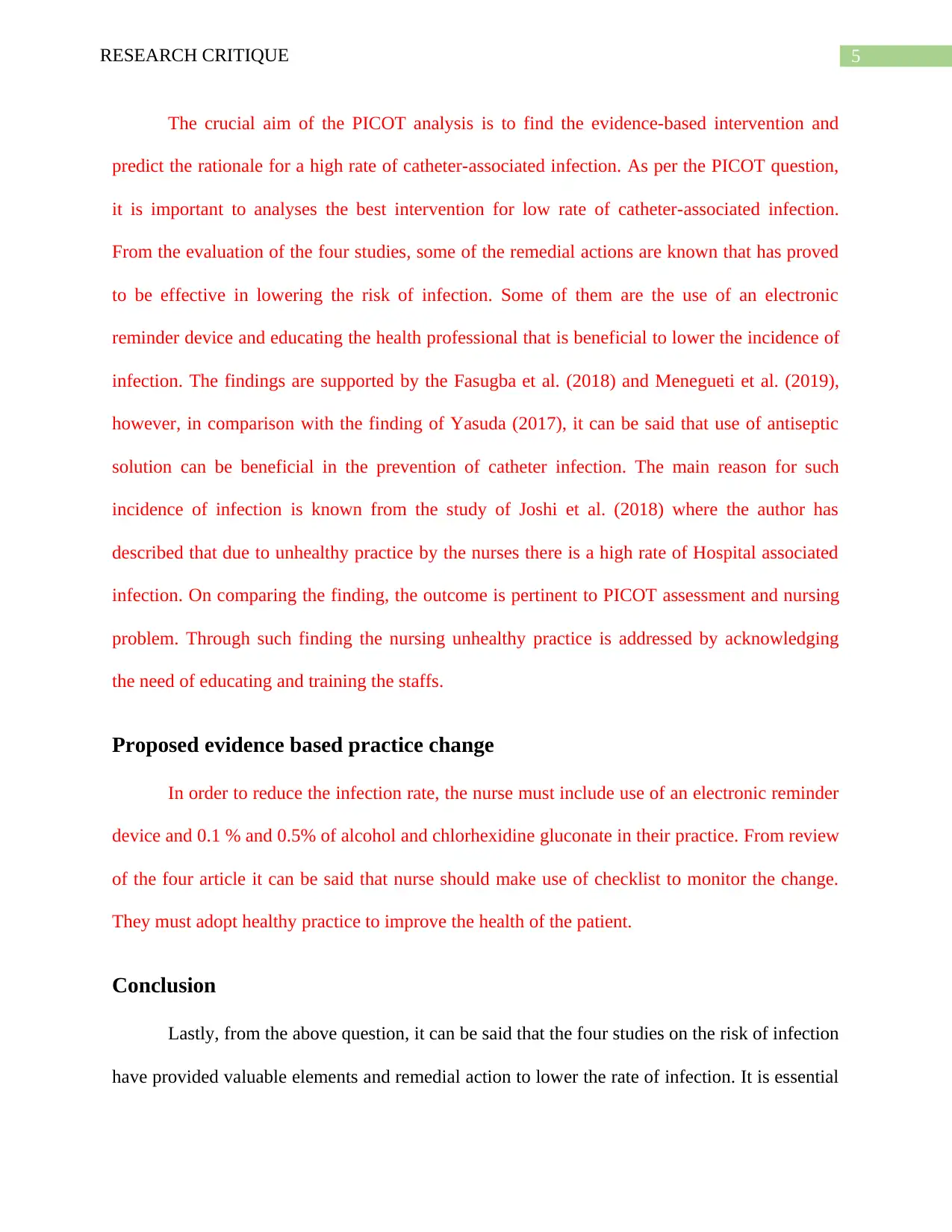
5RESEARCH CRITIQUE
The crucial aim of the PICOT analysis is to find the evidence-based intervention and
predict the rationale for a high rate of catheter-associated infection. As per the PICOT question,
it is important to analyses the best intervention for low rate of catheter-associated infection.
From the evaluation of the four studies, some of the remedial actions are known that has proved
to be effective in lowering the risk of infection. Some of them are the use of an electronic
reminder device and educating the health professional that is beneficial to lower the incidence of
infection. The findings are supported by the Fasugba et al. (2018) and Menegueti et al. (2019),
however, in comparison with the finding of Yasuda (2017), it can be said that use of antiseptic
solution can be beneficial in the prevention of catheter infection. The main reason for such
incidence of infection is known from the study of Joshi et al. (2018) where the author has
described that due to unhealthy practice by the nurses there is a high rate of Hospital associated
infection. On comparing the finding, the outcome is pertinent to PICOT assessment and nursing
problem. Through such finding the nursing unhealthy practice is addressed by acknowledging
the need of educating and training the staffs.
Proposed evidence based practice change
In order to reduce the infection rate, the nurse must include use of an electronic reminder
device and 0.1 % and 0.5% of alcohol and chlorhexidine gluconate in their practice. From review
of the four article it can be said that nurse should make use of checklist to monitor the change.
They must adopt healthy practice to improve the health of the patient.
Conclusion
Lastly, from the above question, it can be said that the four studies on the risk of infection
have provided valuable elements and remedial action to lower the rate of infection. It is essential
The crucial aim of the PICOT analysis is to find the evidence-based intervention and
predict the rationale for a high rate of catheter-associated infection. As per the PICOT question,
it is important to analyses the best intervention for low rate of catheter-associated infection.
From the evaluation of the four studies, some of the remedial actions are known that has proved
to be effective in lowering the risk of infection. Some of them are the use of an electronic
reminder device and educating the health professional that is beneficial to lower the incidence of
infection. The findings are supported by the Fasugba et al. (2018) and Menegueti et al. (2019),
however, in comparison with the finding of Yasuda (2017), it can be said that use of antiseptic
solution can be beneficial in the prevention of catheter infection. The main reason for such
incidence of infection is known from the study of Joshi et al. (2018) where the author has
described that due to unhealthy practice by the nurses there is a high rate of Hospital associated
infection. On comparing the finding, the outcome is pertinent to PICOT assessment and nursing
problem. Through such finding the nursing unhealthy practice is addressed by acknowledging
the need of educating and training the staffs.
Proposed evidence based practice change
In order to reduce the infection rate, the nurse must include use of an electronic reminder
device and 0.1 % and 0.5% of alcohol and chlorhexidine gluconate in their practice. From review
of the four article it can be said that nurse should make use of checklist to monitor the change.
They must adopt healthy practice to improve the health of the patient.
Conclusion
Lastly, from the above question, it can be said that the four studies on the risk of infection
have provided valuable elements and remedial action to lower the rate of infection. It is essential

6RESEARCH CRITIQUE
to understand the high risk of infection and research for the ways to eradicate it because catheter
infection has caused a long stay of the patient in hospital and slowed the recovery rate. Thus the
finding is crucial to address the clinical issue faced by the patients and improved their health.
The four studies have provided valuable information by utilizing evidence-based research.
Though the reviews were found with some limitation, the result found gives new implication in
nursing practice. The nurses can incorporate the use of electronic reminder device and chemical
solutions to lower the incidence of catheter infection. From the analysis of the result, it was
learned that by giving the education to the nurses can improve their unhealthy practice and make
them competent to provide effective care to the patient.
to understand the high risk of infection and research for the ways to eradicate it because catheter
infection has caused a long stay of the patient in hospital and slowed the recovery rate. Thus the
finding is crucial to address the clinical issue faced by the patients and improved their health.
The four studies have provided valuable information by utilizing evidence-based research.
Though the reviews were found with some limitation, the result found gives new implication in
nursing practice. The nurses can incorporate the use of electronic reminder device and chemical
solutions to lower the incidence of catheter infection. From the analysis of the result, it was
learned that by giving the education to the nurses can improve their unhealthy practice and make
them competent to provide effective care to the patient.
Paraphrase This Document
Need a fresh take? Get an instant paraphrase of this document with our AI Paraphraser
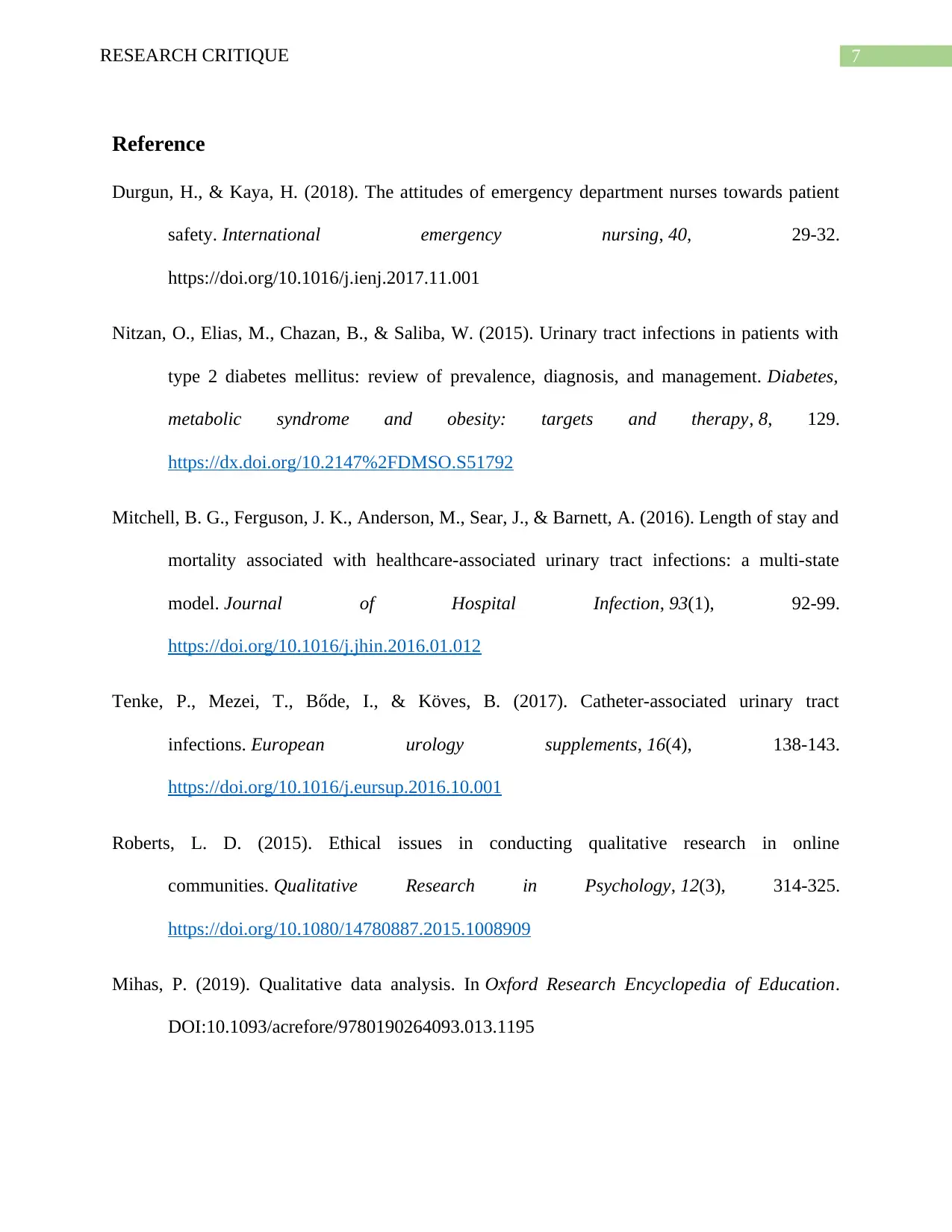
7RESEARCH CRITIQUE
Reference
Durgun, H., & Kaya, H. (2018). The attitudes of emergency department nurses towards patient
safety. International emergency nursing, 40, 29-32.
https://doi.org/10.1016/j.ienj.2017.11.001
Nitzan, O., Elias, M., Chazan, B., & Saliba, W. (2015). Urinary tract infections in patients with
type 2 diabetes mellitus: review of prevalence, diagnosis, and management. Diabetes,
metabolic syndrome and obesity: targets and therapy, 8, 129.
https://dx.doi.org/10.2147%2FDMSO.S51792
Mitchell, B. G., Ferguson, J. K., Anderson, M., Sear, J., & Barnett, A. (2016). Length of stay and
mortality associated with healthcare-associated urinary tract infections: a multi-state
model. Journal of Hospital Infection, 93(1), 92-99.
https://doi.org/10.1016/j.jhin.2016.01.012
Tenke, P., Mezei, T., Bőde, I., & Köves, B. (2017). Catheter-associated urinary tract
infections. European urology supplements, 16(4), 138-143.
https://doi.org/10.1016/j.eursup.2016.10.001
Roberts, L. D. (2015). Ethical issues in conducting qualitative research in online
communities. Qualitative Research in Psychology, 12(3), 314-325.
https://doi.org/10.1080/14780887.2015.1008909
Mihas, P. (2019). Qualitative data analysis. In Oxford Research Encyclopedia of Education.
DOI:10.1093/acrefore/9780190264093.013.1195
Reference
Durgun, H., & Kaya, H. (2018). The attitudes of emergency department nurses towards patient
safety. International emergency nursing, 40, 29-32.
https://doi.org/10.1016/j.ienj.2017.11.001
Nitzan, O., Elias, M., Chazan, B., & Saliba, W. (2015). Urinary tract infections in patients with
type 2 diabetes mellitus: review of prevalence, diagnosis, and management. Diabetes,
metabolic syndrome and obesity: targets and therapy, 8, 129.
https://dx.doi.org/10.2147%2FDMSO.S51792
Mitchell, B. G., Ferguson, J. K., Anderson, M., Sear, J., & Barnett, A. (2016). Length of stay and
mortality associated with healthcare-associated urinary tract infections: a multi-state
model. Journal of Hospital Infection, 93(1), 92-99.
https://doi.org/10.1016/j.jhin.2016.01.012
Tenke, P., Mezei, T., Bőde, I., & Köves, B. (2017). Catheter-associated urinary tract
infections. European urology supplements, 16(4), 138-143.
https://doi.org/10.1016/j.eursup.2016.10.001
Roberts, L. D. (2015). Ethical issues in conducting qualitative research in online
communities. Qualitative Research in Psychology, 12(3), 314-325.
https://doi.org/10.1080/14780887.2015.1008909
Mihas, P. (2019). Qualitative data analysis. In Oxford Research Encyclopedia of Education.
DOI:10.1093/acrefore/9780190264093.013.1195
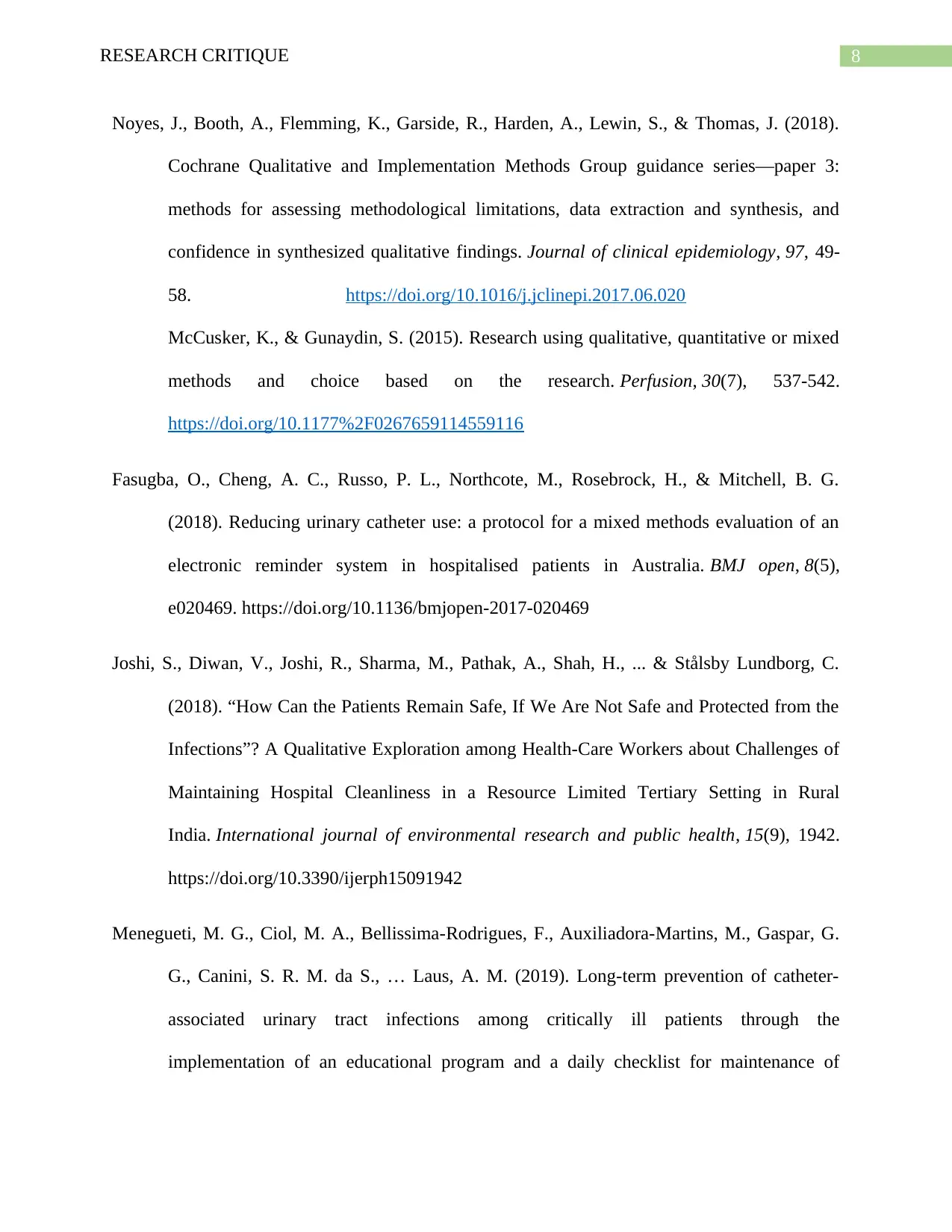
8RESEARCH CRITIQUE
Noyes, J., Booth, A., Flemming, K., Garside, R., Harden, A., Lewin, S., & Thomas, J. (2018).
Cochrane Qualitative and Implementation Methods Group guidance series—paper 3:
methods for assessing methodological limitations, data extraction and synthesis, and
confidence in synthesized qualitative findings. Journal of clinical epidemiology, 97, 49-
58. https://doi.org/10.1016/j.jclinepi.2017.06.020
McCusker, K., & Gunaydin, S. (2015). Research using qualitative, quantitative or mixed
methods and choice based on the research. Perfusion, 30(7), 537-542.
https://doi.org/10.1177%2F0267659114559116
Fasugba, O., Cheng, A. C., Russo, P. L., Northcote, M., Rosebrock, H., & Mitchell, B. G.
(2018). Reducing urinary catheter use: a protocol for a mixed methods evaluation of an
electronic reminder system in hospitalised patients in Australia. BMJ open, 8(5),
e020469. https://doi.org/10.1136/bmjopen-2017-020469
Joshi, S., Diwan, V., Joshi, R., Sharma, M., Pathak, A., Shah, H., ... & Stålsby Lundborg, C.
(2018). “How Can the Patients Remain Safe, If We Are Not Safe and Protected from the
Infections”? A Qualitative Exploration among Health-Care Workers about Challenges of
Maintaining Hospital Cleanliness in a Resource Limited Tertiary Setting in Rural
India. International journal of environmental research and public health, 15(9), 1942.
https://doi.org/10.3390/ijerph15091942
Menegueti, M. G., Ciol, M. A., Bellissima-Rodrigues, F., Auxiliadora-Martins, M., Gaspar, G.
G., Canini, S. R. M. da S., … Laus, A. M. (2019). Long-term prevention of catheter-
associated urinary tract infections among critically ill patients through the
implementation of an educational program and a daily checklist for maintenance of
Noyes, J., Booth, A., Flemming, K., Garside, R., Harden, A., Lewin, S., & Thomas, J. (2018).
Cochrane Qualitative and Implementation Methods Group guidance series—paper 3:
methods for assessing methodological limitations, data extraction and synthesis, and
confidence in synthesized qualitative findings. Journal of clinical epidemiology, 97, 49-
58. https://doi.org/10.1016/j.jclinepi.2017.06.020
McCusker, K., & Gunaydin, S. (2015). Research using qualitative, quantitative or mixed
methods and choice based on the research. Perfusion, 30(7), 537-542.
https://doi.org/10.1177%2F0267659114559116
Fasugba, O., Cheng, A. C., Russo, P. L., Northcote, M., Rosebrock, H., & Mitchell, B. G.
(2018). Reducing urinary catheter use: a protocol for a mixed methods evaluation of an
electronic reminder system in hospitalised patients in Australia. BMJ open, 8(5),
e020469. https://doi.org/10.1136/bmjopen-2017-020469
Joshi, S., Diwan, V., Joshi, R., Sharma, M., Pathak, A., Shah, H., ... & Stålsby Lundborg, C.
(2018). “How Can the Patients Remain Safe, If We Are Not Safe and Protected from the
Infections”? A Qualitative Exploration among Health-Care Workers about Challenges of
Maintaining Hospital Cleanliness in a Resource Limited Tertiary Setting in Rural
India. International journal of environmental research and public health, 15(9), 1942.
https://doi.org/10.3390/ijerph15091942
Menegueti, M. G., Ciol, M. A., Bellissima-Rodrigues, F., Auxiliadora-Martins, M., Gaspar, G.
G., Canini, S. R. M. da S., … Laus, A. M. (2019). Long-term prevention of catheter-
associated urinary tract infections among critically ill patients through the
implementation of an educational program and a daily checklist for maintenance of

9RESEARCH CRITIQUE
indwelling urinary catheters: A quasi-experimental study. Medicine
https://doi.org/10.1097/MD.0000000000014417
Yasuda, H., Sanui, M., Abe, T., Shime, N., Komuro, T., Hatakeyama, J., Lefor, A. K. (2017).
Comparison of the efficacy of three topical antiseptic solutions for the prevention of
catheter colonization: A multicenter randomized controlled study. Critical Care.
https://doi.org/10.1186/s13054-017-1890-z
indwelling urinary catheters: A quasi-experimental study. Medicine
https://doi.org/10.1097/MD.0000000000014417
Yasuda, H., Sanui, M., Abe, T., Shime, N., Komuro, T., Hatakeyama, J., Lefor, A. K. (2017).
Comparison of the efficacy of three topical antiseptic solutions for the prevention of
catheter colonization: A multicenter randomized controlled study. Critical Care.
https://doi.org/10.1186/s13054-017-1890-z
1 out of 10
Related Documents
Your All-in-One AI-Powered Toolkit for Academic Success.
+13062052269
info@desklib.com
Available 24*7 on WhatsApp / Email
![[object Object]](/_next/static/media/star-bottom.7253800d.svg)
Unlock your academic potential
© 2024 | Zucol Services PVT LTD | All rights reserved.




